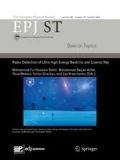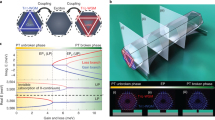Abstract
Resonant light–matter interaction between a molecular transition and a confined electromagnetic field can result in strong coupling where a coherent exchange of energy between light and matter occurs to form a new set of particles called polaritons. Being hybrid particles, polaritons exhibit a wide variety of quantum phenomena such as Bose–Einstein condensation, superfluidity, quantum phase transitions and many others. Recent progress in fundamental understanding and technological advancement in the field of polariton physics has allowed scientists to design and develop many impressive experimental configurations to obtain new insights into the strong interaction of light and matter in different material systems. Among all polariton configurations, microcavity polaritons based on organic materials have been emerging as a promising platform to easily achieve strong light–matter coupling at ambient conditions due to their unique properties compared to the conventional inorganic polariton systems. This mini review covers design principles and typical configurations of organic microcavity polaritons with a short tutorial on essential conditions to be satisfied for the strong coupling regime.

Similar content being viewed by others
References
Isidor Isaac Rabi, Space quantization in a gyrating magnetic field. Phys. Rev. 51(8), 652 (1937)
J.J. Sanchez-Mondragon, N.B. Narozhny, J.H. Eberly, Theory of spontaneous-emission line shape in an ideal cavity. Phys. Rev. Lett. 51(7), 550 (1983)
Daniele Sanvitto, Stéphane. Kéna-Cohen, The road towards polaritonic devices. Nat. Mater. 15(10), 1061–1073 (2016)
Nicholas Rivera, Ido Kaminer, Light-matter interactions with photonic quasiparticles. Nat. Rev. Phys. 2(10), 538–561 (2020)
C.W. Lai, N.Y. Kim, S. Utsunomiya, G. Roumpos, H. Deng, M.D. Fraser, T. Byrnes, P. Recher, N. Kumada, T. Fujisawa, Coherent zero-state and \(\pi \)-state in an exciton-polariton condensate array. Nature 450(7169), 529–532 (2007)
J.J. Hopfield, Theory of the contribution of excitons to the complex dielectric constant of crystals. Phys. Rev. 112(5), 1555 (1958)
Gerhard Rempe, Herbert Walther, Norbert Klein, Observation of quantum collapse and revival in a one-atom maser. Phys. Rev. Lett. 58(4), 353 (1987)
Claude Weisbuch, Mr. Nishioka, A. Ishikawa, Y. Arakawa, Observation of the coupled exciton-photon mode splitting in a semiconductor quantum microcavity. Phys. Rev. Lett. 69(23), 3314 (1992)
G. Christmann, R. Butté, E. Feltin, J.-F. Carlin, N. Grandjean, Room temperature polariton lasing in a GaN/AlGaN multiple quantum well microcavity. Appl. Phys. Lett. 93(5), 051102-1–051102-3 (2008)
D.G. Lidzey, D.D.C. Bradley, T. Virgili, A. Armitage, M.S. Skolnick, S. Walker, Room temperature polariton emission from strongly coupled organic semiconductor microcavities. Phys. Rev. Lett. 82(16), 3316 (1999)
P. Schouwink, H.V. Berlepsch, L. Dähne, R.F. Mahrt, Dependence of Rabi-splitting on the spatial position of the optically active layer in organic microcavities in the strong coupling regime. Chem. Phys. 285(1), 113–120 (2002)
J.R. Tischler, M.S. Bradley, V. Bulović, J.H. Song, A. Nurmikko, Strong coupling in a microcavity LED. Phys. Rev. Lett. 95(3), 036401 (2005)
J. Kasprzak, S. Kundermann, A. Baas, P. Jeambrun, J.M.J. Keeling, F.M. Marchetti, M.H. Szymańska, R. André, J.L. Staehli, Bose–Einstein condensation of exciton polaritons. Nature 443(7110), 409–414 (2006)
S. Kéna-Cohen, S.R. Forrest, Room-temperature polariton lasing in an organic single-crystal microcavity. Nat. Photonics 4(6), 371 (2010)
S. Kéna-Cohen, S.A. Maier, D.D.C. Bradley, Ultrastrongly coupled exciton-polaritons in metal-clad organic semiconductor microcavities. Adv. Opt. Mater. 1(11), 827–833 (2013)
A.F. Kockum, A. Miranowicz, S. De Liberato, S. Savasta, F. Nori, Ultrastrong coupling between light and matter. Nat. Rev. 1(1), 19–40 (2019)
A. Fieramosca, L. Polimeno, V. Ardizzone, L. De Marco, M. Pugliese, V. Maiorano, M. De Giorgi, L. Dominici, G. Gigli, D. Gerace, Two-dimensional hybrid perovskites sustaining strong polariton interactions at room temperature. Sci. Adv. 5(5), eaav9967 (2019)
T. Chervy, X. Jialiang, Y. Duan, C. Wang, L. Mager, M. Frerejean, High-efficiency second-harmonic generation from hybrid light-matter states. Nano Lett. 16(12), 7352–7356 (2016)
A. Amo, J. Lefrère, S. Pigeon, C. Adrados, C. Ciuti, I. Carusotto, R. Houdré, E. Giacobino, A. Bramati, Superfluidity of polaritons in semiconductor microcavities. Nat. Phys. 5(11), 805–810 (2009)
G. Lerario, A. Fieramosca, F. Barachati, D. Ballarini, K.S. Daskalakis, M. De Giorgi, S.A. Maier, G. Gigli, S. Kéna-Cohen, Room-temperature superfluidity in a polariton condensate. Nat. Phys. 13(9), 837–841 (2017)
J. Gao, S. Combrie, B. Liang, P. Schmitteckert, G. Lehoucq, S. Xavier, X. XinAn, K. Busch, D.L. Huffaker, A. De Rossi, Strongly coupled slow-light polaritons in one-dimensional disordered localized states. Sci. Rep. 3(1), 1–6 (2013)
P.A. Ivanov, S.S. Ivanov, N.V. Vitanov, A. Mering, M. Fleischhauer, K. Singer, Simulation of a quantum phase transition of polaritons with trapped ions. Phys. Rev. A 80(6), 060301 (2009)
A. Graf, M. Held, Y. Zakharko, L. Tropf, M.C. Gather, J. Zaumseil, Electrical pumping and tuning of exciton-polaritons in carbon nanotube microcavities. Nat. Mater. 16(9), 911–917 (2017)
X. Liu, T. Galfsky, Z. Sun, F. Xia, E. Lin, Y.-H. Lee, S. Kéna-Cohen, V.M. Menon, Strong light-matter coupling in two-dimensional atomic crystals. Nat. Photonics 9(1), 30–34 (2015)
S. Kéna-Cohen, M. Davanço, S.R. Forrest, Strong exciton-photon coupling in an organic single crystal microcavity. Phys. Rev. Lett. 101(11), 061101-1–061101-5 (2008)
G. Lanty, S. Zhang, J.S. Lauret, E. Deleporte, P. Audebert, S. Bouchoule, X. Lafosse, J. Zuñiga-Pérez, F. Semond, D. Lagarde, Hybrid cavity polaritons in a ZnO-perovskite microcavity. Phys. Rev. B 84(19), 195449-1–195449-5 (2011)
D. Kottilil, M. Gupta, K. Tomar, F. Zhou, C. Vijayan, P.K. Bharadwaj, W. Ji, Cost-effective realization of multimode exciton-polaritons in single-crystalline microplates of a layered metal-organic framework. ACS Appl. Mater. Interfaces 11(7), 7288–7295 (2019)
F. Herrera, J. Owrutsky, Molecular polaritons for controlling chemistry with quantum optics. J. Chem. Phys. 152(10), 100902-1–100902-19 (2020)
J. Flick, N. Rivera, P. Narang, Strong light-matter coupling in quantum chemistry and quantum photonics. Nanophotonics 7(9), 1479–1501 (2018)
P. Törmä, W.L. Barnes, Strong coupling between surface plasmon polaritons and emitters: a review. Rep. Prog. Phys. 78(1), 013901 (2014)
C. Cohen-Tannoudji, J. Dupont-Roc, G. Grynberg, Photons and Atoms—Introduction to Quantum Electrodynamics (Wiley-Interscience, New York, 1989)
D.S. Dovzhenko, S.V. Ryabchuk, Yu.P. Rakovich, I.R. Nabiev, Light-matter interaction in the strong coupling regime: configurations, conditions, and applications. Nanoscale 10(8), 3589–3605 (2018)
E. Orgiu, J. George, J.A. Hutchison, E. Devaux, J.F. Dayen, B. Doudin, F. Stellacci, C. Genet, J. Schachenmayer, C. Genes, Conductivity in organic semiconductors hybridized with the vacuum field. Nat. Mater. 14(11), 1123–1129 (2015)
M. Hertzog, M. Wang, J. Mony, K. Börjesson, Strong light-matter interactions: a new direction within chemistry. Chem. Soc. Rev. 48(3), 937–961 (2019)
E. Peter, P. Senellart, D. Martrou, A. Lemaître, J. Hours, J.M. Gérard, J. Bloch, Exciton-photon strong-coupling regime for a single quantum dot embedded in a microcavity. Phys. Rev. Lett. 95(6), 067401 (2005)
J.P. Reithmaier, G. Sȩk, A. Löffler, C. Hofmann, S. Kuhn, S. Reitzenstein, L.V. Keldysh, V.D. Kulakovskii, T.L. Reinecke, A. Forchel, Strong coupling in a single quantum dot–semiconductor microcavity system. Nature 432(7014), 197–200 (2004)
I.D. Rukhlenko, D. Handapangoda, M. Premaratne, A.V. Fedorov, A.V. Baranov, C. Jagadish, Spontaneous emission of guided polaritons by quantum dot coupled to metallic nanowire: Beyond the dipole approximation. Opt. Express 17(20), 17570–17581 (2009)
A. Shalabney, J. George, J.A. Hutchison, G. Pupillo, C. Genet, T.W. Ebbesen, Coherent coupling of molecular resonators with a microcavity mode. Nat. Commun. 6(1), 1–6 (2015)
P.A. Hobson, W.L. Barnes, D.G. Lidzey, G.A. Gehring, D.M. Whittaker, M.S. Skolnick, S. Walker, Strong exciton–photon coupling in a low-Q all-metal mirror microcavity. Appl. Phys. Lett. 81(19), 3519–3521 (2002)
R. Cerna, D. Sarchi, T.K. Paraïso, G. Nardin, Y. Léger, M. Richard, B. Pietka, E. Daif, F. Morier-Genoud, V. Savona, Coherent optical control of the wave function of zero-dimensional exciton polaritons. Phys. Rev. B 80(12), 121309 (2009)
Darius Urbonas, Thilo Stöferle, Fabio Scafirimuto, Ullrich Scherf, R.F. Mahrt, Zero-dimensional organic exciton-polaritons in tunable coupled Gaussian defect microcavities at room temperature. ACS Photonics 3(9), 1542–1545 (2016)
F. Zhou, I. Abdelwahab, K. Leng, K.P. Loh, W. Ji, 2D perovskites with giant excitonic optical nonlinearities for high-performance sub-bandgap photodetection. Adv. Mater. 31(48), 1904155 (2019)
A. P. Schlaus, M. S. Spencer, X. Y. Zhu, Light–matter interaction and lasing in lead halide perovskites. Acc. Chem. Rese. 52(10), 2950–2959 (2019)
D. Kottilil, M. Gupta, C. Vijayan, P.K. Bharadwaj, W. Ji, Multiphoton-pumped highly polarized polariton microlasers from single crystals of a dye-coordinated metal-organic framework. Adv. Funct. Mater. 30(32), 2003294 (2020)
H. He, E. Ma, Y. Cui, Y. Jiancan, Yu. Yang, T. Song, W. Chuan-De, X. Chen, B. Chen, G. Qian, Polarized three-photon-pumped laser in a single MOF microcrystal. Nat. Commun. 7(1), 1–7 (2016)
X. Wang, Q. Liao, X. Zhenzhen, W. Yishi, L. Wei, L. Xiaomei, F. Hongbing, Exciton-polaritons with size-tunable coupling strengths in self-assembled organic microresonators. ACS Photonics 1(5), 413–420 (2014)
H. Bahsoun, T. Chervy, A. Thomas, K. Bö rjesson, M. Hertzog, J. George, E. Devaux, J.A. Hutchison, T.W. Ebbesen, Electronic light-matter strong coupling in nanofluidic Fabry-Pérot cavities. ACS Photonics 5(1), 225–232 (2018)
D. M. Coles, Q. Chen, L. C. Flatten, J. M. Smith, K. Müllen, A. Narita, D. G. Lidzey, Strong exciton–photon coupling in a nanographene filled microcavity. Nano Lett. 17(9), 5521–5525 (2017)
D.M. Coles, Y. Yang, Y. Wang, R.T. Grant, R.A. Taylor, S.K. Saikin, A. Aspuru-Guzik, D.G. Lidzey, J.K.-H. Tang, J.M. Smith, Strong coupling between chlorosomes of photosynthetic bacteria and a confined optical cavity mode. Nat. Commun. 5(1), 1–9 (2014)
C.P. Dietrich, A. Steude, L. Tropf, M. Schubert, N.M. Kronenberg, An exciton-polariton laser based on biologically produced fluorescent protein. Sci. Adv. 2(8), e1600666 (2016)
J. Keeling, S. Kéna-Cohen, Bose–Einstein condensation of exciton-polaritons in organic microcavities. Ann. Rev. Phys. Chem. 71, 435–459 (2020)
H.S. Quah, W. Chen, M.K. Schreyer, H. Yang, M.W. Wong, W. Ji, J.J. Vittal, Multiphoton harvesting metal-organic frameworks. Nat. Commun. 6(1), 1–7 (2015)
X. Jiang, L. Zhang, S. Liu, Y. Zhang, Z. He, Wenjia Li, Feng Zhang, Yihuang Shi, Yu. Wei Lü, W. Li, Ultrathin metal-organic framework: an emerging broadband nonlinear optical material for ultrafast photonics. Adv. Opt. Mater. 6(16), 1800561 (2018)
Author information
Authors and Affiliations
Corresponding author
Rights and permissions
About this article
Cite this article
Kottilil, D., Babusenan, A., Vijayan, C. et al. Strong light–matter interaction in organic microcavity polaritons: essential criteria, design principles and typical configurations. Eur. Phys. J. Spec. Top. 230, 4091–4097 (2021). https://doi.org/10.1140/epjs/s11734-021-00224-8
Received:
Accepted:
Published:
Issue Date:
DOI: https://doi.org/10.1140/epjs/s11734-021-00224-8




